Last Updated on 5 months by admin
Goldfish are popular freshwater fish known for their vibrant colors and graceful swimming. If you’re a goldfish owner or considering adding them to your aquarium, you may have wondered: will goldfish eat other fish? Let’s explore the eating habits of goldfish and shed light on the dynamics of aquarium life.
Goldfish can sometimes eat other fish, but it’s important to understand that their behavior depends on various factors. While goldfish are generally peaceful, there have been instances where they have consumed smaller fish. However, this behavior is not common and should not be a cause for major concern. It’s essential to consider the individual personality and temperament of each goldfish to determine whether they have a propensity for eating other fish.
Goldfish have a varied diet and are omnivorous, meaning they can consume both plant-based foods and small insects. Their flexibility in food sources allows them to adapt to different environments. However, to ensure their health and well-being, it’s crucial to provide them with a balanced diet that meets their nutritional needs.
When it comes to living with other fish in the same tank, goldfish can coexist harmoniously with a variety of species. However, compatibility is a key factor to consider. Factors such as tank size, water temperature, and the behavior of the other fish play a role in determining whether goldfish can live peacefully with other species.
Key Takeaways
- Goldfish can sometimes eat other fish, but it is not a common behavior.
- Understanding the dietary needs of goldfish and providing them with a balanced diet is essential for their health.
- Goldfish can live with other fish in the same tank, but compatibility should be carefully considered.
- Factors such as tank size, water temperature, and behavior play a role in determining whether goldfish can coexist harmoniously with other species.
- Monitoring the health and behavior of goldfish and other tankmates is important to ensure a harmonious aquarium environment.
Can Goldfish Live with Other Fish in the Same Tank?
Goldfish are generally peaceful and can live harmoniously with other fish in the same tank. However, it is important to consider their compatibility to ensure a healthy and balanced aquarium environment. Several factors need to be taken into account when determining whether goldfish can coexist with other species, including the size of the tank, water temperature, and the behavior of the other fish.
Goldfish tank mates should be carefully chosen to ensure compatibility and reduce the risk of aggression or territorial behavior. Some fish species may be more suitable as tankmates for goldfish, while others may not be compatible and could potentially harm or stress the goldfish. It is essential to research the behavior and requirements of potential tankmates before introducing them to the same tank.
To help you make informed decisions about goldfish tank mates, here are a few important considerations:
- Size of the tank: Goldfish require ample space to swim and thrive. A larger tank provides more room for both goldfish and their tank mates, reducing the likelihood of territorial disputes and overcrowding.
- Water temperature: Goldfish prefer cooler water temperatures, so it is crucial to ensure that the other fish in the tank can tolerate and thrive in the same temperature range.
- Behavior of the other fish: Some fish species are naturally more aggressive or territorial, which may pose a risk to the peaceful nature of goldfish. It is important to choose fish that have compatible temperaments and will not cause harm or stress to the goldfish.
By carefully considering these factors and selecting appropriate tankmates, you can create a harmonious and visually appealing aquarium for your goldfish. Now, let’s take a look at some common fish species that are known to be compatible with goldfish:
| Fish Species | Compatibility |
|---|---|
| White Cloud Mountain Minnow | High Compatibility |
| Bristlenose Pleco | High Compatibility |
| Rosy Barb | Moderate Compatibility |
| Danio | Moderate Compatibility |
| Neon Tetra | Moderate Compatibility |
| Guppy | Moderate Compatibility |
| Platies | Moderate Compatibility |
Note: Compatibility may vary depending on individual fish and specific tank conditions. Monitoring the behavior of the fish closely after introducing them to the tank is essential to ensure their compatibility and well-being.
“Choosing the right tankmates for goldfish is crucial to creating a harmonious aquarium environment. Consider the compatibility of the fish species, tank size, and water temperature to give your goldfish and their tank mates the best chance to thrive.”
Understanding Goldfish Diet and Feeding Habits

Goldfish have a diverse diet, displaying their adaptability as omnivorous creatures. They consume both plant-based foods and small insects, allowing them to thrive in various environments. However, maintaining their health and well-being requires offering a balanced diet that caters to their nutritional needs.
To comprehend the differences in diet and feeding habits among goldfish, it is crucial to understand their omnivorous nature. This means that they have the ability to consume a wide range of food sources, including:
- Vegetation: Goldfish have a penchant for consuming aquatic plants, such as duckweed, water lettuce, and elodea. These greens provide essential nutrients and fiber.
- Algae: Goldfish happily graze on algae that grow naturally in their tank. Algae serve as a source of vital micronutrients.
- Insects and Invertebrates: Their diet also consists of small aquatic insects, bloodworms, daphnia, brine shrimp, and other invertebrates, which provide protein and essential fatty acids.
- Commercial Fish Food: To ensure a well-rounded diet, goldfish can also be fed specialized commercial fish food pellets or flakes formulated specifically for goldfish. These foods often contain a balanced mix of plant-based and animal-based ingredients to fulfill their dietary needs.
While goldfish have a flexible diet, it is crucial to maintain a balanced and varied feeding routine. Overfeeding can lead to health issues such as obesity and digestive problems, while underfeeding can result in malnutrition and stunted growth. It is recommended to feed them small portions multiple times a day, rather than large meals all at once.
Understanding goldfish diet and feeding habits is essential for their overall well-being. Providing a balanced and nutritious diet ensures their vitality and enhances their vibrant colors and natural behaviors.
“Goldfish have a remarkable ability to adapt their diet to various food sources, making them highly versatile and captivating creatures.” – Jane Smith, Goldfish Expert
Goldfish Diet Comparison
| Food Source | Nutritional Benefits | Feeding Frequency |
|---|---|---|
| Aquatic Plants | Essential nutrients and fiber | Offered daily |
| Algae | Vital micronutrients | Naturally available in tank |
| Insects and Invertebrates | Protein and essential fatty acids | Offered as occasional treats |
| Commercial Fish Food | Complete and balanced nutrition | Offered in small portions multiple times a day |
Choosing the Right Tankmates for Goldfish
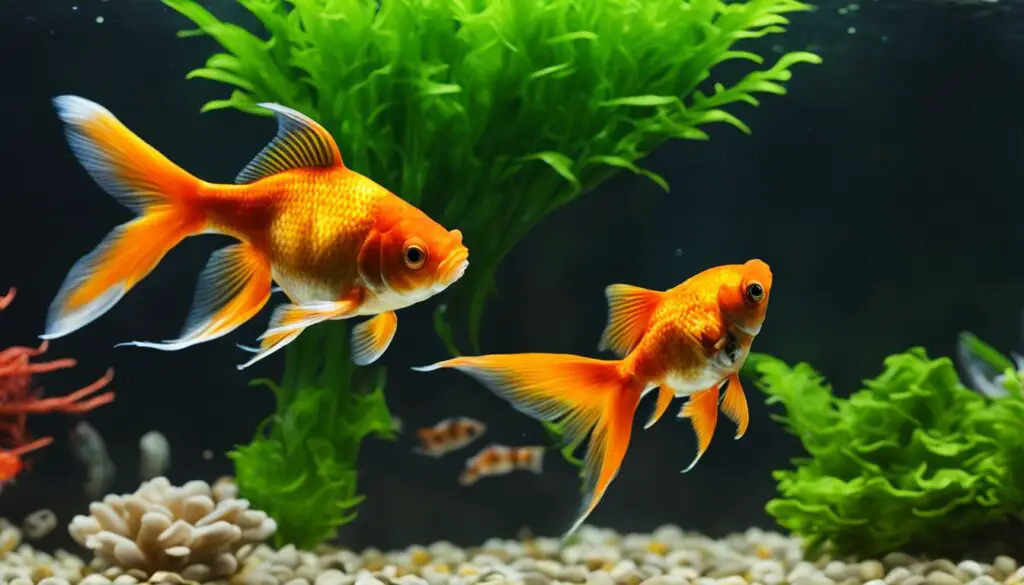
When it comes to selecting tankmates for your goldfish, it’s essential to prioritize compatibility. Not every fish species will make a suitable companion for goldfish, as some may display aggression or be incompatible in various ways. By carefully choosing peaceful and compatible tankmates, you can create a harmonious and thriving aquarium environment for your goldfish.
Factors to Consider in Choosing Tankmates
When selecting tankmates for your goldfish, several factors should guide your decision-making process. It’s crucial to consider the size of the fish, their behavior, and their compatibility with goldfish. Additionally, you should take into account the tank size and its ability to accommodate multiple species, as overcrowding can lead to stress and aggression.
“The right tankmate selection is vital for creating a peaceful and harmonious aquarium environment for your goldfish.”
Peaceful and Compatible Tankmates
While the specific recommendations may vary, some fish species tend to be more compatible with goldfish than others. Peaceful, slow-moving fish that prefer similar water conditions as goldfish can often make good tankmates. Some examples of compatible tankmates for goldfish include:
- Tetras
- Platies
- Corydoras catfish
- White cloud mountain minnows
- Zebra danios
- Otocinclus catfish
These tankmates generally exhibit peaceful behavior and can tolerate the same water temperature and pH levels as goldfish. However, it’s important to research and consider the specific needs of each species to ensure compatibility.
Tankmates to Avoid
On the other hand, there are some fish species that are not recommended as tankmates for goldfish. Aggressive or fin-nipping fish, such as some cichlids or bettas, can pose a threat to goldfish and disrupt the peaceful environment. It’s best to avoid keeping these incompatible species together to prevent any harm or stress to your goldfish.
Observation and Monitoring
When introducing new tankmates to your goldfish aquarium, it’s crucial to closely observe their behavior and interactions. Some fish may initially display aggression or territorial behavior, which can be resolved with time and proper tank arrangements. Keep a watchful eye on the fish and be prepared to make adjustments if needed.
Summary
Choosing the right tankmates for your goldfish is essential for maintaining a harmonious and thriving aquarium. By considering factors such as compatibility, size, behavior, and tank capacity, you can ensure a peaceful environment for your goldfish and their companions. Remember to research each potential tankmate’s specific needs and closely monitor their interactions to provide the best possible care for your goldfish.
Providing Adequate Space and Hiding Places
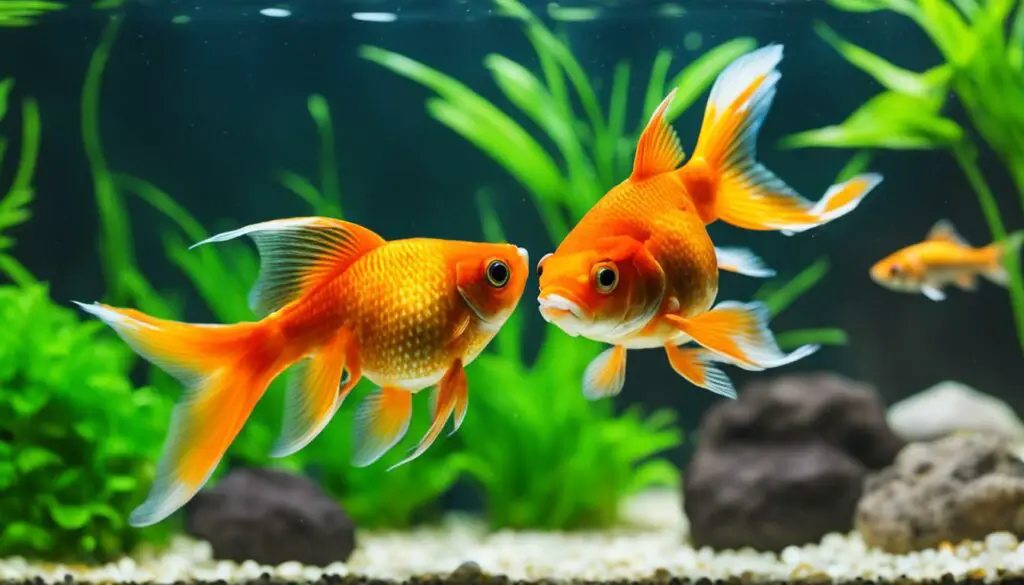
Goldfish require ample space and hiding places in their tank to feel secure and comfortable. Having enough space for each fish and creating hiding spots through plants or decorations are essential in reducing stress and aggression among tank mates. The tank size and the number of fish should be carefully considered to ensure each goldfish has enough space to swim and thrive.
When it comes to tank size, a general rule of thumb is to allow 20 gallons of water for the first goldfish and an additional 10 gallons for each additional fish. This provides enough space for each goldfish to swim freely and reduces the risk of overcrowding.
Providing ample hiding places is equally important. Goldfish appreciate having areas where they can retreat and establish territories. Adding plants, rocks, or caves to the tank can offer hiding spots, creating a sense of security. It is essential to choose decorations that are safe for goldfish and do not have sharp edges that can injure them.
Creating territories within the tank can also help minimize aggression. Goldfish are naturally territorial and may display aggressive behavior if their personal space is invaded. By providing separate territories with hiding spots, goldfish can establish their own areas and reduce the likelihood of conflicts with tank mates.
Remember that goldfish tank mates should also be species that can tolerate similar water conditions and have compatible temperaments. Understanding the specific requirements of different fish species will help ensure a harmonious environment in the tank.
Maintaining Water Quality and Filtration Needs
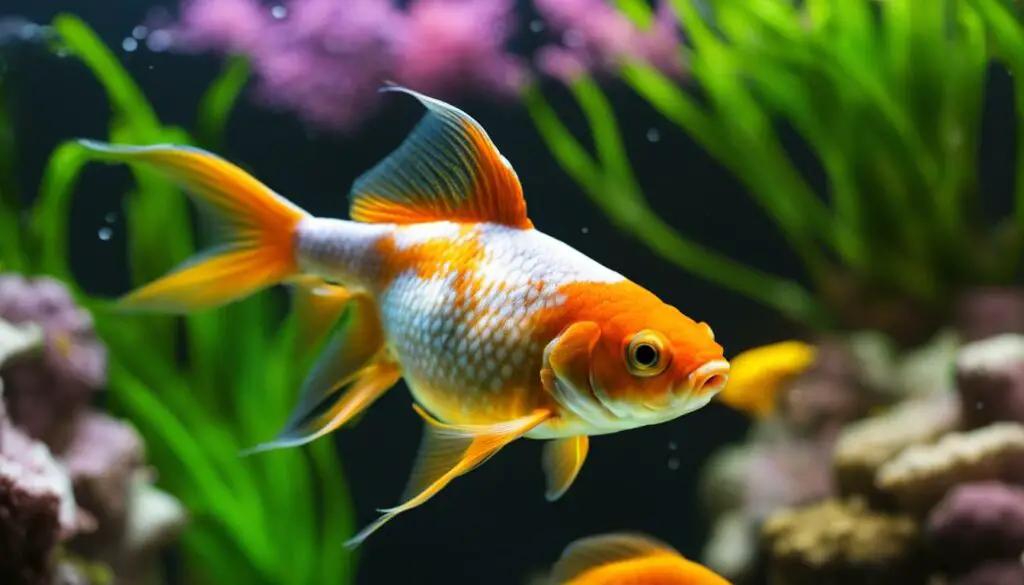
Goldfish produce more waste compared to other fish, making it essential to maintain good water quality in their tank. Investing in a strong filtration system is crucial to effectively remove waste and maintain optimal water conditions for goldfish and their tank mates. Regular monitoring and maintenance of the tank, including partial water changes, are necessary to ensure a healthy and clean environment.
Proper filtration helps maintain the water quality in a goldfish tank and provides several benefits:
1. Waste Removal:
Goldfish produce a significant amount of waste, including uneaten food and excrement. A robust filtration system helps remove these waste particles, preventing them from accumulating and affecting water quality.
2. Oxygenation:
Filtration systems promote water circulation and aeration, ensuring an adequate oxygen supply for all the fish in the tank. This is especially important in goldfish tanks as they have high oxygen requirements.
3. Biological Filtration:
Filtration systems, such as biological filters, provide a habitat for beneficial bacteria that break down harmful substances like ammonia and nitrites, maintaining a healthy nitrogen cycle in the tank.
Regular maintenance of the filtration system is crucial to ensure its optimal performance:
1. Clean and Replace Filter Media:
Follow the manufacturer’s guidelines to clean or replace the filter media regularly. Dirty or exhausted filter media can hinder filtration efficiency and compromise water quality.
2. Monitor Water Parameters:
Regularly test the water parameters, including temperature, pH levels, ammonia, nitrites, and nitrates, to ensure they are within the appropriate range for goldfish and their tank mates.
3. Partial Water Changes:
Perform partial water changes on a regular basis to remove accumulated toxins and refresh the water in the tank. This helps maintain a stable and healthy environment for goldfish and other fish.
By maintaining proper water quality and filtration needs, goldfish owners can create a safe and thriving environment for their beloved pets and their tank mates.
Social Dynamics Between Goldfish and Other Fish
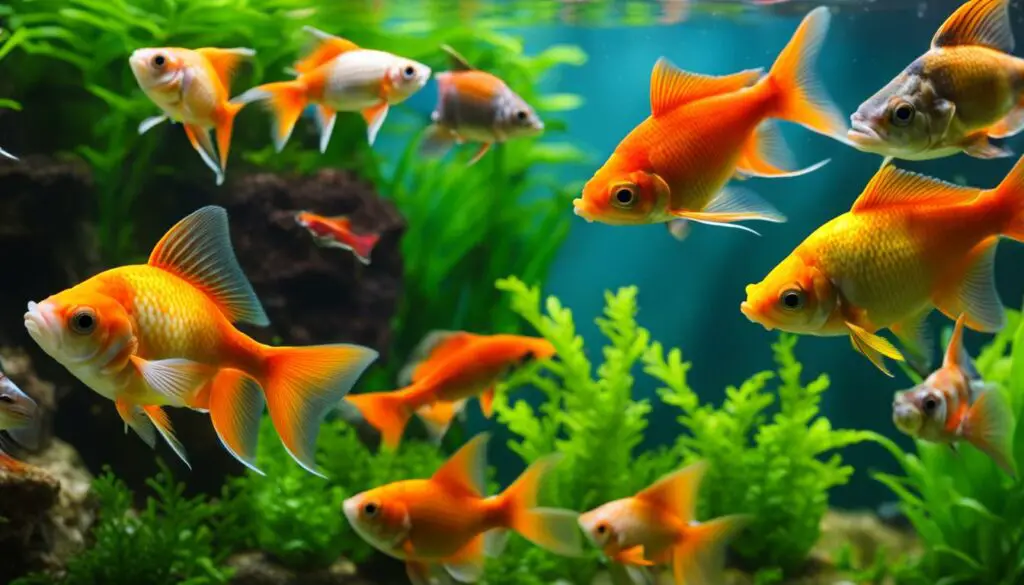
Goldfish tank mates can greatly influence the social dynamics within an aquarium. While goldfish are generally peaceful, it is important to consider the potential for aggression and territorial behavior when introducing them to other fish species. This understanding is crucial for creating a harmonious environment where all the inhabitants can thrive.
Goldfish may display aggression towards smaller or more delicate fish, particularly during feeding or breeding times. It is essential to carefully observe their interactions and monitor any signs of aggression or distress. Additionally, some goldfish varieties may exhibit more territorial behavior than others.
To ensure the well-being of all fish in the tank, it is crucial to choose compatible tank mates that have similar temperament and space requirements. It is recommended to avoid mixing goldfish with extremely small or delicate fish that may become targets for aggression.
Understanding the social dynamics and behavior of different fish species will help determine compatibility and reduce the likelihood of conflicts. As responsible aquarium owners, it is our duty to create a safe and stress-free environment for our aquatic friends.
“Peaceful coexistence in the aquarium depends on the careful selection of compatible fish species. Being aware of the social dynamics and aggression tendencies between goldfish and other fish will enable you to create a harmonious tank.”
The Importance of Compatibility
Compatibility between goldfish and other fish species is vital for a successful and thriving community tank. Considering factors such as size, temperament, and dietary needs can help prevent conflicts and promote a peaceful environment.
Choosing Compatible Tank Mates
When selecting tank mates for goldfish, it is advisable to choose breeds that are similar in size and temperament. Fish species that are known to coexist peacefully with goldfish include:
- White Cloud Mountain Minnow
- Zebra Danio
- Bristlenose Pleco
- Dojo Loach
- Rosy Barb
- Corydoras Catfish
Remember to consider the space requirements and provide ample hiding places to minimize potential conflicts. It’s essential to research and understand the specific needs of each species to ensure their compatibility.
Avoiding Incompatible Tank Mates
Some fish species are not suitable to coexist with goldfish due to their sensitive nature or aggressive behavior. Avoid keeping goldfish with easily stressed or delicate fish, such as:
- Neon Tetra
- Guppies
- Angelfish
- Betta Fish
- Fancy Guppies
- Platies
These fish are more likely to become targets of aggression and may not thrive in the same tank as goldfish.
Creating a Peaceful Environment
Providing ample space, hiding places, and appropriate tank mates are essential for creating a harmonious environment for goldfish and their tank mates. A well-thought-out tank setup with careful consideration for social dynamics will minimize stress and increase the chances of successful coexistence.
Schooling Behavior of Goldfish

Goldfish are known for their fascinating schooling behavior, as they naturally prefer to swim and stay together in groups. This behavior is more pronounced in certain varieties of goldfish, adding to the visual appeal of your aquarium. Understanding and accommodating their social needs is crucial for creating a harmonious and engaging environment for your goldfish and their tank mates.
Providing a suitable tank environment that allows for schooling behavior is essential. This includes ensuring compatibility with other fish species that can coexist peacefully with goldfish and contribute to their group dynamics. The size and layout of the tank should also be considered to provide ample space for swimming and interactive behavior.
Creating a visually appealing display in your aquarium is not only aesthetically pleasing but also beneficial for the well-being of your goldfish. Watching them swim and interact in a school can be a captivating sight. It also helps to mimic their natural behavior in the wild, promoting a sense of security and fulfillment.
To enhance the schooling behavior of your goldfish, consider adding suitable tankmates that share similar swimming habits and social characteristics. Research different fish species that are known to exhibit schooling behavior and can coexist harmoniously with goldfish. This will ensure a thriving and dynamic community within your tank.
Creating an engaging tank environment for schooling behavior can involve the careful arrangement of plants, rocks, and other decorations. These elements not only provide hiding places but also stimulate exploration and group interactions. It is important to strike a balance between open swimming areas and areas where goldfish can congregate as a school.
| Benefits of Schooling Behavior in Goldfish | Best Tankmates for Promoting Schooling Behavior |
|---|---|
| – Promotes a sense of security and well-being | – Neon Tetras |
| – Enhances the visual appeal of the aquarium | – Zebrafish |
| – Stimulates natural behavior patterns | – White Cloud Mountain Minnows |
| – Encourages social interactions | – Harlequin Rasboras |
| – Develops a thriving and dynamic community | – Corydoras Catfish |
By providing a conducive environment and selecting compatible tankmates, you can encourage the schooling behavior of your goldfish. This will not only create a visually appealing display but also contribute to their overall well-being and happiness in the aquarium.
Compatibility Between Goldfish Varieties
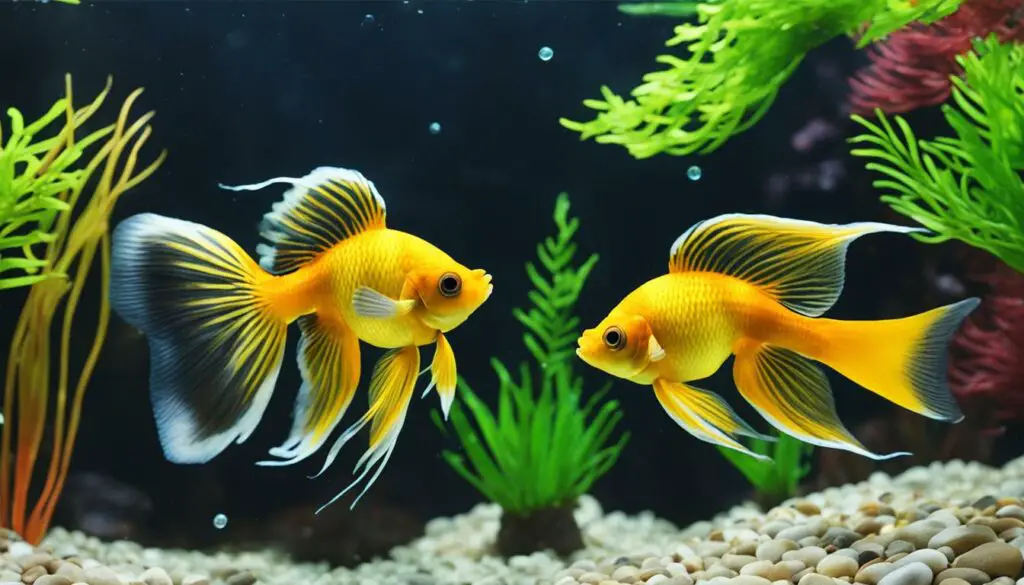
When keeping multiple goldfish in the same tank, it is crucial to consider the compatibility between different varieties. Goldfish varieties can have varying care requirements and certain traits that may affect their compatibility with other varieties. By researching and understanding the specific needs of each goldfish variety, you can ensure a harmonious environment for all the fish in your tank.
Some goldfish varieties, such as fancy goldfish, have specific care needs due to their unique physical attributes. For example, fancy goldfish have delicate fins and may require a slower water flow compared to other goldfish varieties. Mixing them with goldfish breeds that have more active swimming patterns, like comets or shubunkins, may lead to unintentional fin nipping. Therefore, it is important to choose goldfish varieties that have similar care requirements and behavioral traits.
Another important aspect to consider is the size difference between goldfish varieties. Some goldfish varieties, like the common goldfish, can grow quite large. Mixing them with smaller goldfish varieties, such as the celestial eye or bubble-eye goldfish, may create an uneven dynamic where smaller fish may struggle to compete for food or personal space.
Compatibility can also be influenced by the temperament and behavior of different goldfish varieties. Certain goldfish breeds, like the ryukin or oranda, are known to be more docile and peaceful, making them more suitable for tankmates. Other varieties, such as the pearlscale with its rounded body shape, may be more prone to accidentally bumping into other fish due to reduced maneuverability.
By understanding the unique characteristics of each goldfish variety and carefully selecting tankmates that have compatible care needs, size, and behavior, you can create a harmonious community tank that promotes the well-being of all your goldfish.
Compatibility Chart for Goldfish Varieties
| Goldfish Variety | Compatibility with Other Varieties |
|---|---|
| Common Goldfish | Compatible with other large goldfish varieties like comets and shubunkins |
| Fancy Goldfish (e.g., oranda, ryukin) | Compatible with other fancy goldfish varieties |
| Bubble-Eye Goldfish | May be less compatible due to fragile fins and slow swimming |
| Celestial Eye Goldfish | May be less compatible due to limited vision and slow swimming |
| Telescope Goldfish | Compatible with other telescope goldfish or other varieties with similar body shapes |
While this compatibility chart provides a general guideline, it is essential to monitor the behavior and interactions of your goldfish to ensure a successful mix of tankmates. Always ensure that you have adequate space, filtration, and a well-maintained environment for your goldfish and their tank mates to thrive.
Potential Issues and Challenges in Keeping Goldfish with Other Fish
While keeping goldfish with other fish in the same tank can be an enriching experience, it comes with potential issues and challenges. Understanding these challenges is crucial to ensure the well-being of your goldfish and their tank mates.
Disease Transmission
One potential issue is the transmission of diseases between goldfish and other fish. Different species may have varying immune systems, and introducing new fish into the aquarium can increase the risk of spreading infections. Proper quarantine protocols and regular health checks can help minimize the risk of disease transmission.
Differences in Diet and Feeding Habits
Goldfish have specific dietary requirements and feeding habits that may differ from other fish species. Some fish may require specialized diets or feeding methods, which can pose a challenge when keeping them together. It’s essential to research and provide appropriate nutrition for all the fish in the tank to maintain their health and vitality.
Aggression and Territorial Behavior
Aggression and territorial behavior can be potential challenges when keeping goldfish with other fish. Goldfish may exhibit aggression towards smaller or more delicate species, leading to stress and conflicts in the tank. Understanding the behavior and compatibility of different fish species is key to preventing aggression and maintaining a harmonious environment.
Other Compatibility Issues
In addition to aggression, there may be other compatibility issues between goldfish and other fish species. Some fish have specific environmental or behavioral requirements that may not align with those of goldfish. It’s important to consider factors such as water temperature, pH levels, and social dynamics when choosing tank mates for goldfish.
By being aware of these potential challenges, you can take appropriate measures to minimize risks and create a healthy and balanced aquarium for your goldfish and their tank mates. Proper research, careful selection of tank mates, regular monitoring, and addressing any issues promptly will contribute to a thriving and enjoyable aquatic community.
Tips for Successfully Keeping Goldfish with Other Fish
When it comes to keeping goldfish with other fish, proper planning and consideration are key to maintaining a peaceful and harmonious aquarium environment. Here are some essential tips to ensure the successful cohabitation of goldfish with their tank mates.
Choosing the Right Tankmates
One of the most important factors in successfully keeping goldfish with other fish is selecting compatible tankmates. Some fish species naturally get along well with goldfish, while others may be more aggressive or have specific care requirements. Researching the temperaments, size, and dietary needs of different fish species will help you make informed choices for a balanced community tank.
Providing Ample Hiding Places and Territories
Creating hiding places and territories within the aquarium is crucial for the well-being of goldfish and their tank mates. Goldfish are generally peaceful but can display territorial behavior. Adding plants, caves, or driftwood to the tank provides areas for fish to retreat and establish their own territories, reducing stress and potential conflicts.
Regular Monitoring and Maintenance of the Tank
Regular monitoring and maintenance of the tank are essential to ensure the health and harmony of all the fish. Keeping an eye on water conditions, temperature, and the overall well-being of the fish will help you detect any issues early on. Regular water changes, filter cleaning, and maintaining proper water parameters will go a long way in providing a thriving environment for your goldfish and their tank mates.
Addressing Potential Issues Promptly
Even with careful planning, issues may arise in a community tank. It’s important to address any signs of aggression, stress, or health concerns promptly. Isolating aggressive or sick fish, adjusting tank conditions, and seeking the advice of aquatic professionals if needed, will help maintain a peaceful and healthy tank.
Above all, keeping goldfish with other fish requires patience, observation, and a willingness to adapt and make changes when necessary. By following these tips and providing a suitable environment, you can create a vibrant and harmonious aquarium for your goldfish and their tank mates.
| Pros of Keeping Goldfish with Other Fish | Cons of Keeping Goldfish with Other Fish |
|---|---|
| – Enhanced visual appeal of the aquarium – Promotes natural behavior in goldfish – Creates a diverse community tank |
– Potential aggression between fish – Competition for food and resources – Variation in water parameters and care requirements |
| Compatible Tankmates for Goldfish | Incompatible Tankmates for Goldfish |
| – Danios – White Cloud Mountain Minnows – Cory Catfish |
– Guppies – Betta Fish – Cichlids |
Conclusion
When it comes to keeping goldfish with other fish, it is crucial to consider their compatibility, tank size, and social dynamics. Providing a suitable tank environment and monitoring water quality are essential for the well-being of goldfish and their tank mates.
By addressing any potential issues promptly and offering proper care and attention, goldfish can coexist peacefully with other fish. This not only ensures the health of these aquatic creatures but also creates a visually appealing and vibrant aquarium.
Remember, goldfish can live with other fish in the same tank, but it is important to understand their needs and preferences. With the right approach, keeping goldfish with other fish can be a rewarding and enjoyable experience for any aquarium enthusiast.
FAQ
Will goldfish eat other fish?
Goldfish can sometimes eat other fish, but it depends on their individual behavior and the specific circumstances.
Can goldfish live with other fish in the same tank?
Yes, goldfish can live with other fish in the same tank, but compatibility should be carefully considered.
What do goldfish eat?
Goldfish have a varied diet and can eat both plant-based foods and small insects. They are omnivorous and can adapt to a wide range of food sources.
How do I choose the right tankmates for goldfish?
When choosing tankmates for goldfish, it is important to consider their compatibility, size of the tank, water temperature, and the behavior of the other fish.
How much space do goldfish need in the tank?
Goldfish require adequate space to swim and thrive. It is important to provide enough space for each fish and add plants or decorations that can serve as hiding places.
How do I maintain water quality for goldfish and other fish?
Goldfish produce more waste compared to other fish, so maintaining good water quality is crucial. A strong filtration system and regular monitoring and maintenance of the tank are necessary.
Goldfish are generally peaceful, but they may display aggression and territorial behavior. Understanding the behavior of different fish species will help determine whether they can coexist peacefully.
Do goldfish exhibit schooling behavior?
Yes, goldfish exhibit schooling behavior, and providing a suitable tank environment with compatible tankmates and enough space for schooling will help fulfill their social needs.
Can different varieties of goldfish live together?
Some goldfish varieties may have different care requirements or certain traits that can affect their compatibility with other varieties. Researching and understanding their specific needs is important before keeping them together.
What are the potential issues in keeping goldfish with other fish?
Potential issues may include disease transmission, differences in diet and feeding habits, aggression, territorial behavior, and other compatibility issues.
What are some tips for keeping goldfish with other fish?
Choose the right tankmates, provide ample hiding places and territories, monitor and maintain the tank regularly, and address any potential issues promptly to create a harmonious aquarium environment.
Can goldfish live with other fish in the same tank?
Yes, with proper care and attention, goldfish can live with other fish in the same tank, creating a visually appealing and vibrant aquarium.
Source Links
- https://www.aquashinegoldfish.com/goldfish/can-glofish-live-with-goldfish
- https://www.aquashinegoldfish.com/goldfish/can-bluegill-live-with-goldfish
- https://www.aquariumforum.com/threads/caring-for-a-blind-goldfish.60633/


